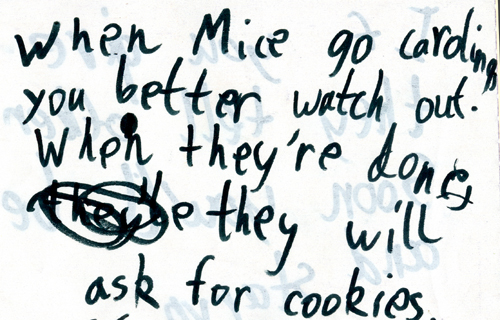In the comments on the post about the younger Free-Ride offspring’s science fair project, Isabel asks:
I don’t remember if I’ve seen your response to this question before, but, if you don’t mind my asking, how much do you help your kids with their homework/science projects?
Actually, I’m pretty sure I haven’t explicitly answered this question on the blog before, partly because the answer is something that constantly feels like it’s being renegotiated. We’re constantly trying to find the right level of assistance/engagement/oversight that ensures that the kids are:
- really mastering the material they’re supposed to be learning,
- maybe seeing some of the stuff they’re learning has cool extensions or consequences (because this is where a lot of the fun in learning seems to be),
- showing their teachers what they know (so that there’s some chance of their grades reflecting that knowledge),
- doing their damned homework (please don’t get me started on this),
- finishing their damned homework before bedtime.
As you might imagine, these goals are sometimes in tension with each other. Also, it turns out that I and my better half often have a fair bit of work that we’re trying to accomplish at home (“homework”, if you will), and no one is stepping up to help us with that — the point being that we have to strive for some level of efficiency in supervising/helping the sprogs, else get our hands on a time machine.
I should share two nuggets of experience that I think inform my strategies on helping my kids with homework and projects. One is an interaction I had with a colleague maybe six years ago, when the elder Free-Ride offspring was in kindergarten. This colleague had a child in fifth grade and was bemoaning the fact that the school seemed to be assigning projects that it would be practically impossible for a fifth grader to do on his or her own. “So the parents end up doing much of the projects, because what choice do they have? If you resist it, it’s your kid who gets the bad grade.”
This state of affairs, dear readers, rather pissed me off. It helped me decide that, if my own clever kid’s best effort was not enough to satisfy the requirements of a given project or assignment, I should be conferring with my kid’s teacher about whether that project or assignment was actually appropriate.
The other experience that has informed my view here is what it was like to get help on schoolwork from my dad. His approach was, in a word, Socratic. I could approach him with what seemed like s straightforward question (e.g., how do I get started balancing this redox reaction) and he could be counted on to launch into no fewer than twenty minutes of questioning designed to help establish what I already understood and to help me figure out how to extend that knowledge to the problem at hand.
When I was a teenager, this bugged the heck out of me — sometimes enough to motivate me to engage in my own (more focused) Socratic inquiry. But darned if I didn’t develop some effective problem-solving strategies as a result of his questioning.
So, we pretty much went Socratic on the sprogs as soon as they gave any evidence of paying attention to what we were saying. (The Friday Sprog Blogging archives will attest to this.) And, this naturally carried over to homework once they started bringing it home. We routinely asked questions like:
- What are you supposed to do here?
- What can you tell me about how to do that?
- How can you check whether doing it that way works, or whether your answer is a reasonable one?
- Can you think of any other strategy for figuring this out?
Obviously this is not the most efficient way to get the homework done, at least in the short term. But it does seem to have helped the sprogs to get better at answering their own questions and developing their own problem-solving strategies, if only to get their Socratic parents to shut up.
For longer term projects, like science fair projects, we get a little more involved, not so much in directing the projects as in helping the kids assess whether the projects are plausibly doable in the time available and with the materials we have on hand or are willing to purchase. We help somewhat in developing the initial idea (I want to grow mold) to something like a testable hypothesis (although again, this help is Socratic in flavor). As well, as they’re coming up with their experimental design, we’ll ask more questions to help them think about whether their observations will really help answer the questions they’re trying to answer, what confounders might complicate things, and so on.
The execution of the experiment is then up to the sprog.
I will cop to beating the time-management drum loudly and regularly for this round of science fair projects. Both concerned biological systems and data that was either necessarily to be collected over time (mold growth) or of a sort that you couldn’t count on being able to collect all of the night before (because the rabbit gets bored hunting for treats after a while). Also, since the elder Free-Ride offspring’s project involved research with a USDA regulated vertebrate animal, I was a hardass about getting the kid to commit to an experimental protocol in time for a veterinarian to give feedback on it before signing the required forms (and before any data collection commenced).
I did not micromanage how the sprogs kept their project notebooks. This meant that the younger Free-Ride offspring had to reap what was sown (with data recorded on dated but not chronologically ordered pages) when it came time to collect and analyze the data. I have a feeling that’s a lesson that’s going to stick.
As far as data analysis and visual representation of the data, this is something I discussed with the sprogs (again, Socratically) as they were deciding on the approach that they thought made the most sense. Once they settled on an approach, it was up to them to execute it.
They wrote up (and typed out) their own narratives for their project boards. They also decided how to organize text blocks, photographs, tables, and graphs on the project board. I, however, wielded the can of spray adhesive, on the theory that the sprogs would get into more trouble with sticky hands than I would.
Our approach to helping here is not always successful from the point of view of getting the sprogs to do their best work (or to actually turn it in). But, I think it has been a reasonable strategy in terms of ensuring that the sprogs know how to do that work, even the more challenging long-term projects. Also, they bring home grades that reflect their work, not their parents’.









